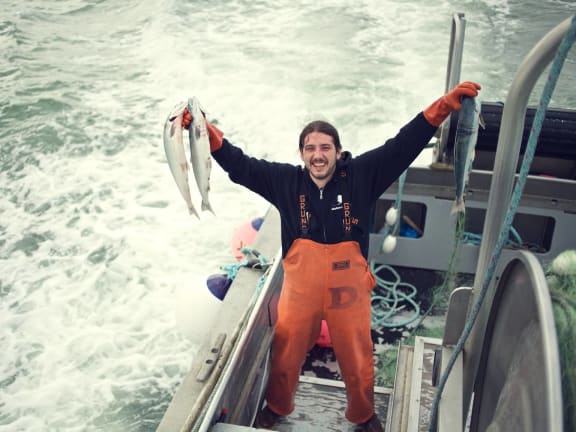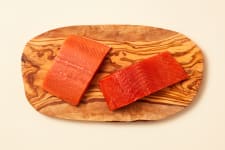I’m not sure if it’s the springtime air, the longer bouts of daylight, the impending solar eclipse energy, or all of the above — but today I feel strongly compelled to share with you, dear members, OUR BIG WHY.
To break down for you the elemental reason why we started this company. Or more accurately, to unpack for you the constellation of reasons that all came to a head, which, in time, served to catalyze my husband Arron (Wild Alaskan Company’s founder + CEO) to dive head-first into the story of his destiny.
To tell the story right, we have to start at the beginning — and in the beginning there existed salmon. In fact, it’s believed that Pacific salmon evolved some 20 million years ago, leaving in the waters of this glorious earth a creature with a wisdom so innate, that it’s etched into the very nuance of its movements. There’s an anciency to this fish, I would even say a spirituality. A creature whose physical journey is a testament to the magic of symbiosis, with a trail that receives and endows life force to not only itself, but to all that it encounters. For millennia, the salmon has persisted — as a creature with a trek. An animal with a mission. A fish that is meant to do more than just swim, but, in fact, to really travel. And for millennia, humans have held a sacred relationship with this fish.
Enter the rise of industrial scale open-net salmon farming (one of the many forms of aquaculture) just 40 or so years ago, like a jarring scratch from the needle on a record. A practice that, as my husband and countless other folks from fishing families and communities will attest, was nothing short of catastrophic. Catastrophic for the stocks of wild salmon, to their (and our) environment, and to the myriad individuals whose entire lives and livelihoods relied on harvesting, processing, distributing and even cooking and serving wild salmon.
The salmon farming industry would argue that aquaculture has been around for thousands of years, and yes, there is some precedent for raising small amounts of fish in a non-industrial setting. But the relatively newer practice of which we speak (and its many ramifications) absolutely pales in comparison to the millions of years during which wild salmon have existed. While it may be true that some version of farming fish isn’t entirely new, it has never been done at this scale. In upholding these practices — knowing what we know about the harmful effects of open-net salmon farming — we are essentially gambling with the wellbeing of our planet.
Consider that Arron was born in 1982, when almost no one had even heard of farmed salmon. But by the time he was 18, farmed salmon had completely transformed the seafood industry, with a practice that’s still — despite its profitability — not fully tested. A practice that would industrialize the production of salmon, flooding the global marketplace with fish bred in captivity to grow fat quickly, under conditions that paid no respect to their evolutionary blueprint.
Suddenly there was a monumental influx of farmed salmon in direct competition with the time-tested wild salmon of millenia — two products with the same name that were, in fact, fundamentally different. As far as consumers knew, “salmon is salmon,” leaving them vulnerable to a classic bait-and-switch scenario, in which the cheaper, more accessible product — farmed salmon — would, in their mind, inevitably prevail. Had there not suddenly existed an overabundance of farmed fish, the wild ones would have been perfectly sellable. Needless to say, this had an adverse effect on the wild Alaskan salmon market with classic issues of supply and demand, and on the communities of Alaska that relied on it.
But the rise of industrial-scale aquaculture is just one piece of a complicated puzzle. There were more factors that would impact the trajectory of the wild salmon market. Ironically, thanks to Alaska’s exceptionally strong sustainability practices, the state experienced some notably large salmon runs in the mid-nineties. While this would ordinarily be considered a positive, in that moment it created an inundation of both wild and farmed salmon that was too much for the market to bear.
As a consequence, Alaska experienced a catastrophic price collapse of its salmon market in the early 2000s (right as Arron set out for college) from which many fishing families never fully recovered. For families like the Kallenbergs, just one of these challenges would have been enough to complicate everyday life.
This great tangle of circumstances set the stage for the many pain points that Arron began to feel as the son and grandson of Alaskan sockeye salmon fishermen. As the years passed, Arron witnessed the emergence of existential threats to salmon’s ecosystem, such as Pebble Mine; and the prevalence of seafood fraud throughout America. In 2010, he first put pen to paper and began working on a business plan — ruminating on ways to reconnect Americans to real, wild-caught Alaskan seafood. As he recounts on the Our Story Page of our website, in 2017, he finally reached his tipping point and founded the Wild Alaskan Company.
For my husband, Wild Alaskan Company is so much more than a business. It is a mandate laced with a profound reverence for his family's legacy. After all, years before Arron was even born, his own grandfather Robert C. Kallenberg wrote a master’s thesis about the conservation of sockeye salmon; and his own father Walt, like Robert, would fish Bristol Bay for decades — regardless of all the volatility described above.
These were men who lived lives indebted to the fish, in sync with their migrations, in service to their streams and seas. As a kid, Arron got to behold, and even regularly partake of the wonder of this symbiotic relationship. But his adolescence was met with the havoc that salmon farming wreaked on the wild Alaskan salmon industry, which he felt firsthand when his family had to sell their home, downsize and come to terms with a new reality of scarcity. Between the hardship of that fateful moment, the increase in seafood fraud (which he himself experienced at restaurants all around the United States), and the looming prospect of Pebble Mine, which was yet another threat to the salmon’s habitat — Arron simply had enough. He knew that after honing his craft as a software engineer for years outside of Alaska, it was time to reciprocate — to give back to Alaska all that it had given to him.
The company was born out of fury and faith. Fury toward the disregard with which open-net salmon farming seems to operate — but faith that American consumers know better, want better and can have access to better wild-caught Alaskan seafood. His purpose was clear: “We are the ancestors of our generation’s great-great-grandchildren — stewards of the future, trying not to do anything that we would regret ten thousand years from now.”
And so it is that we carry our purpose — inspired by the fish, informed by the past and led by our hearts.
Live Wild!
Monica
Pictured above: My husband Arron aboard the Mary K — the commercial sockeye fishing vessel that was designed and built by his father Walt.






